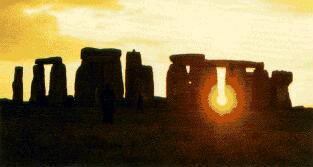
 Stonehenge
Stonehenge

Stonehenge is a world famous prehistoric monument, dating back thousands of years, begun in 2800BC. It is sited on Salisbury Plain, 10 miles to the north of Salisbury. A unique megalithic monument on Salisbury Plain in Wiltshire, England. Its alleged connection with the Druids dates from the 17th c., when people's ideas about what constituted 'the past' were very vague. In the 12th c. it was believed to be a monument over King Arthur's grave; other theories have attributed it to the Phoenicians, Romans, Vikings, and visitors from other worlds; modern theory inclines to the view that it was a temple. Scientific study and excavation have identified three main constructional phases between c.3000 BC and c.1500 BC, i.e. it was completed in the Bronze Age. The circular bank and ditch, double circle of 'bluestones' (spotted dolerite), and circle of sarsen stones (some with white lintels), are concentric, and the main axis is aligned on the midsummer sunrise--an orientation that was probably for ritual rather than scientific purposes.
Built between 3100 and 1550 BC, is by far the most famous prehistoric megalith in Europe. Of all the megalithic monuments in Europe, Stonehenge is unique because of the precision of its architecture and its extended use throughout history.
It is a site of great interest since no one is entirely sure why it was built. There are many theories, ranging from an astronomical observatory (it is aligned such that it can predict eclipses etc) to religious temples to a calendar.
A circular group of massive, upright stones, the Stonehenge monument was once thought to have been a type of prehistoric astronomical observatory or clock for predicting the seasons and other astronomical events.
Another earlier notions was that Stonehenge was connected with the Druids, a caste of Celtic priests
These days it is normally used as a site for a pop festival every summer solstice for New Age Travellers - unfortunately for them the police now regularly turn them away year after year so as to avoid damage to the stones, annoyance to the locals, litter, etc.


 Return to the Fridge door
Return to the Fridge door